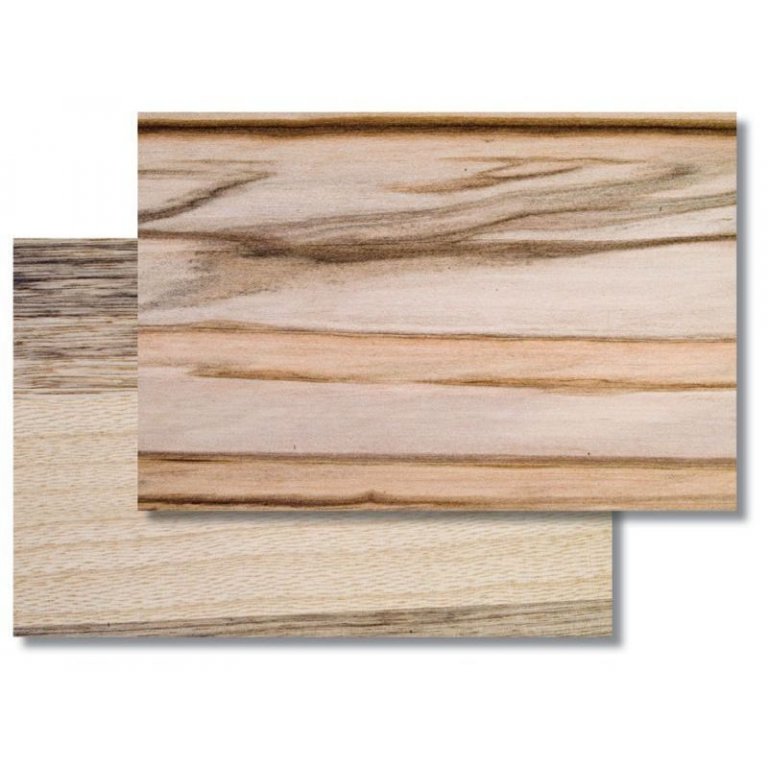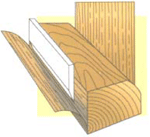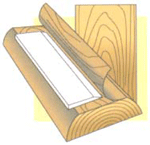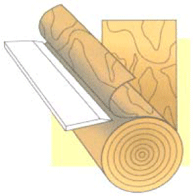
| Article No. | |
|---|---|
| Material | Real wood veneer on special paper substrate |
| Veneer thickness | approx. 0.6 mm |
| grain | lengthwise |
| Properties | neutral glued (E1), ex works 2 x sanded (grain 120 and 150) |
Larger formats up to 2500 x 1240 mm on request from our team for professionals.
The veneer with paper backing from the series “Character” is distinguished from the other Decoflex veneers by its very striking patterns, which come about as a result of a joining technique called „mismatch“. This involves combining pieces of veneer flitch to one another in such a way that chaotic and richly contrasting areas and bridges are achieved but the sheet of veneer nonetheless exhibits a (even if unique) consistency within the borders of its complete surface (starting at 1240 x 2240 mm).
Attributes and Applications: Decoflex is a real wood veneer that is bonded onto a special paper backing sheet; the veneer is then “broken” parallel to the fibres in such a way that these breaks cannot be seen on the veneer surface. This gives the material an extremely high flexibility along the direction of the fibres and makes it very suitable for work on rounded shapes that until this development would not have been able to be veneered at all (minimum radius is about 5 mm). The stiffness at right angles to the fibre of the veneer remains unchanged through this process, as does its resistance to splintering.
Apart from its potential use on curved surfaces of diverse materials (see “Treatment” below), Decoflex is of course great for use on flat surfaces as well. The best argument for the use of Decoflex veneer on flat surfaces is the time and cost savings that are realized because it can be worked with much faster and more efficiently than the classic veneers. On top of being used as veneer, Decoflex can also be applied as a “pure” material (i.e. on its own). Examples include using it as a book cover, for model making purposes, for producing jewellery and accessories (e.g. place mats) and much more.
The backing of Decoflex is made out of special brown paper whose tones are selected by the manufacturer to approximately match the colour of the veneer (e.g. chamois for maple, dark brown for walnut). The glue between the veneer and the paper corresponds to the E1 norm (ecologically safe) and is waterproof. Decoflex is nevertheless not suitable for outdoor use.
Cutting techniques for producing veneer: All veneers are cut from a log. Picturing the work being done with a very broad chisel will make it easier to imagine the cutting process. The pattern on the surface of the veneer is primarily determined by the cutting technique used. Our veneers are cut in the following ways:
Quarter slicing: The log is cut in such a way that the veneer will have a design that looks like almost perfectly parallel lines running the distance. This regularity is a result of making a perpendicular cut through the annual growth rings.
 |
Plain slicing: The design on the veneer is much more irregular than with quarter slicing. You must imagine a log that has been cut lengthwise – the veneer sheet is then cut parallel to the original lengthwise cut, i.e. in comparison to the quarter slice, a cutting angle that is turned 90 degrees. This produces what is called a “cathedral grain” pattern.
 |
This cut is pretty easy to imagine just from the name: the cutter essentially peels off a layer around the outside of the log. This allows you to theoretically make the largest pieces of veneer because you can just keep on turning the log till the end – the cut is no longer limited by the diameter of the log. The resulting patterns are irregular and wavy.
 |
Treatment: Decoflex can be glued to the most diverse types of surfaces. The choice of glue depends primarily on the type of carrier material to which the Decoflex is being attached. If you are working without a veneer press, the manufacturer recommends the use of high quality contact adhesives (e.g. PATTEX GEL POWER GLUE). If the Decoflex is being applied with a press, normal PVA glues (e.g. PONAL EXPRESS) or formaldehyde glue can be used. In both cases the manufacturer recommends that you not be sparing with the glue.
If the glue is being applied with a GLUE SCRAPER instead of a spray gun you must be sure to apply the glue on one surface at right angles to the other. Before the veneer is placed on the carrier material, you should place pieces of paper or cardboard along the outer edges so that the Decoflex can subsequently be forcefully pressed down and smoothed out from the middle outwards (your paper stops the veneer from attaching first at the edges) during which time the paper should be removed little by little (allowing the edges to finally be covered with veneer).
Be sure when doing this work to follow the instructions provided by the glue and/or varnish manufacturers. The glues and varnishes used must definitely not contain any incompatible substances. The manufacturer also recommends that the Decoflex veneer, the glue, the carrier material, as well as any other working materials, all be stored in the same room because this will help to prevent bubbles or cracks from developing in the veneer. After the gluing you should wait 4 or 5 days before applying any varnish so that the glue has enough time to cure completely.
Despite the sanding already done at the factory (120 and 150 grit), if you want to achieve a perfect finish you must sand the surface with very fine grit sandpaper again (e.g. 240 or 320 grit) before applying any varnish. NEVER use a water-soluble varnish; solvent-based varnish is always required (e.g. CLOU WOOD VARNISH L1). If you want to oil the veneer you will do well with our BIOFARBEN HARD OIL.
Free standard delivery within Germany and free collection from Modulor in Berlin for orders over 89 €.
5,95 € shipping costs, if order value is less than 89 € (DE)
2,95 € for pick-up at the store in Berlin, if order value is less than 89 €
Express and forwarding shipping
From 19 € express surcharge you will receive your order particularly quickly with standard shipping within Germany.
From 69€ is the cost of shipping within Germany. You can recognize articles with forwarding shipping in the store by the truck symbol .
Especially for Berlin
From 34.90 € courier shipping for standard and forwarding goods.
- Free returns for standard shipping within Germany
- Extended, voluntary return policy of 30 days for complete, undamaged goods in their original packaging
- You are responsible for the cost of returns for forwarding goods and returns from a country outside Germany
Excluded from returns
Excluded from returns are sections of rolled goods, cut-to-size pieces and other goods made especially for you, as well as used goods, newspapers, magazines and periodicals, Modulor vouchers and items that we do not carry in our range but have ordered at your request.
Good to know: The furniture variants in our configurators that can be delivered quickly are not cut to size, but standard formats that can be returned.
| Article No. | |
|---|---|
| Material | Real wood veneer on special paper substrate |
| Veneer thickness | approx. 0.6 mm |
| grain | lengthwise |
| Properties | neutral glued (E1), ex works 2 x sanded (grain 120 and 150) |
Larger formats up to 2500 x 1240 mm on request from our team for professionals.
The veneer with paper backing from the series “Character” is distinguished from the other Decoflex veneers by its very striking patterns, which come about as a result of a joining technique called „mismatch“. This involves combining pieces of veneer flitch to one another in such a way that chaotic and richly contrasting areas and bridges are achieved but the sheet of veneer nonetheless exhibits a (even if unique) consistency within the borders of its complete surface (starting at 1240 x 2240 mm).
Attributes and Applications: Decoflex is a real wood veneer that is bonded onto a special paper backing sheet; the veneer is then “broken” parallel to the fibres in such a way that these breaks cannot be seen on the veneer surface. This gives the material an extremely high flexibility along the direction of the fibres and makes it very suitable for work on rounded shapes that until this development would not have been able to be veneered at all (minimum radius is about 5 mm). The stiffness at right angles to the fibre of the veneer remains unchanged through this process, as does its resistance to splintering.
Apart from its potential use on curved surfaces of diverse materials (see “Treatment” below), Decoflex is of course great for use on flat surfaces as well. The best argument for the use of Decoflex veneer on flat surfaces is the time and cost savings that are realized because it can be worked with much faster and more efficiently than the classic veneers. On top of being used as veneer, Decoflex can also be applied as a “pure” material (i.e. on its own). Examples include using it as a book cover, for model making purposes, for producing jewellery and accessories (e.g. place mats) and much more.
The backing of Decoflex is made out of special brown paper whose tones are selected by the manufacturer to approximately match the colour of the veneer (e.g. chamois for maple, dark brown for walnut). The glue between the veneer and the paper corresponds to the E1 norm (ecologically safe) and is waterproof. Decoflex is nevertheless not suitable for outdoor use.
Cutting techniques for producing veneer: All veneers are cut from a log. Picturing the work being done with a very broad chisel will make it easier to imagine the cutting process. The pattern on the surface of the veneer is primarily determined by the cutting technique used. Our veneers are cut in the following ways:
Quarter slicing: The log is cut in such a way that the veneer will have a design that looks like almost perfectly parallel lines running the distance. This regularity is a result of making a perpendicular cut through the annual growth rings.
 |
Plain slicing: The design on the veneer is much more irregular than with quarter slicing. You must imagine a log that has been cut lengthwise – the veneer sheet is then cut parallel to the original lengthwise cut, i.e. in comparison to the quarter slice, a cutting angle that is turned 90 degrees. This produces what is called a “cathedral grain” pattern.
 |
This cut is pretty easy to imagine just from the name: the cutter essentially peels off a layer around the outside of the log. This allows you to theoretically make the largest pieces of veneer because you can just keep on turning the log till the end – the cut is no longer limited by the diameter of the log. The resulting patterns are irregular and wavy.
 |
Treatment: Decoflex can be glued to the most diverse types of surfaces. The choice of glue depends primarily on the type of carrier material to which the Decoflex is being attached. If you are working without a veneer press, the manufacturer recommends the use of high quality contact adhesives (e.g. PATTEX GEL POWER GLUE). If the Decoflex is being applied with a press, normal PVA glues (e.g. PONAL EXPRESS) or formaldehyde glue can be used. In both cases the manufacturer recommends that you not be sparing with the glue.
If the glue is being applied with a GLUE SCRAPER instead of a spray gun you must be sure to apply the glue on one surface at right angles to the other. Before the veneer is placed on the carrier material, you should place pieces of paper or cardboard along the outer edges so that the Decoflex can subsequently be forcefully pressed down and smoothed out from the middle outwards (your paper stops the veneer from attaching first at the edges) during which time the paper should be removed little by little (allowing the edges to finally be covered with veneer).
Be sure when doing this work to follow the instructions provided by the glue and/or varnish manufacturers. The glues and varnishes used must definitely not contain any incompatible substances. The manufacturer also recommends that the Decoflex veneer, the glue, the carrier material, as well as any other working materials, all be stored in the same room because this will help to prevent bubbles or cracks from developing in the veneer. After the gluing you should wait 4 or 5 days before applying any varnish so that the glue has enough time to cure completely.
Despite the sanding already done at the factory (120 and 150 grit), if you want to achieve a perfect finish you must sand the surface with very fine grit sandpaper again (e.g. 240 or 320 grit) before applying any varnish. NEVER use a water-soluble varnish; solvent-based varnish is always required (e.g. CLOU WOOD VARNISH L1). If you want to oil the veneer you will do well with our BIOFARBEN HARD OIL.
Free standard delivery within Germany and free collection from Modulor in Berlin for orders over 89 €.
5,95 € shipping costs, if order value is less than 89 € (DE)
2,95 € for pick-up at the store in Berlin, if order value is less than 89 €
Express and forwarding shipping
From 19 € express surcharge you will receive your order particularly quickly with standard shipping within Germany.
From 69€ is the cost of shipping within Germany. You can recognize articles with forwarding shipping in the store by the truck symbol .
Especially for Berlin
From 34.90 € courier shipping for standard and forwarding goods.
- Free returns for standard shipping within Germany
- Extended, voluntary return policy of 30 days for complete, undamaged goods in their original packaging
- You are responsible for the cost of returns for forwarding goods and returns from a country outside Germany
Excluded from returns
Excluded from returns are sections of rolled goods, cut-to-size pieces and other goods made especially for you, as well as used goods, newspapers, magazines and periodicals, Modulor vouchers and items that we do not carry in our range but have ordered at your request.
Good to know: The furniture variants in our configurators that can be delivered quickly are not cut to size, but standard formats that can be returned.